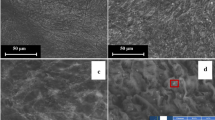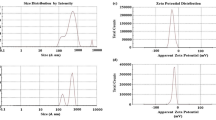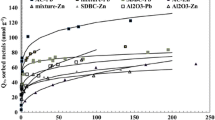Abstract
Serpentine has weak immobilization capacity for Pb(II), especially under acidic conditions. In order to improve its application potential, a new biological modification method was adopted, i.e., the serpentine powder was weathered by Aspergillus niger and the fungus-serpentine aggregation (FSA) formed was investigated for its Pb(II) immobilization potential and underlying mechanism. Batch adsorption of Pb(II) by FSA closely followed the Langmuir model, while the maximum adsorption capacity of FSA (370.37 mg/g) was significantly higher than fungal mycelium (31.85 mg/g) and serpentine (8.92 mg/g). The adsorption process can be accurately simulated by pseudo-second-order kinetic model. Our data revealed the loading of organic matter is closely related to the adsorption of FSA, and the stronger immobilization capacity was mainly related to its modified porous organic-inorganic composite structure with extensive exchangeable ions. Moreover, FSA is an economical bio-material with excellent Pb(II) adsorption (pH = 1–8) along with significantly lower desorption efficiency (pH = 3–8), especially under acidic conditions. These findings provide a new perspective to explore the usage of fungus-minerals aggregation on heavy metals immobilization in acidic environments.
Key Points | |
• Co-culture of Aspergillus niger and serpentine produced a porous composite material like fungus-serpentine aggregation. | |
• Fungus-serpentine aggregation has a surprisingly higher adsorption capacity of Pb(II) and significantly lower desorption efficiency under acidic conditions. | |
• The loading of organic matter is closely related to the adsorption of FSA. |
Graphical abstract









Similar content being viewed by others
Data availability
All datasets obtained for this study are included in the manuscript/Supplementary material.
References
Abollino O, Aceto M, Malandrino M, Sarzanini C, Mentasti E (2003) Adsorption of heavy metals on Na-montmorillonite. Effect of pH and organic substances. Water Res 37(7):1619–1627. https://doi.org/10.1016/S0043-1354(02)00524-9
Adebowale KO, Unuabonah I, Olu-Owolabi BI (2006) The effect of some operating variables on the adsorption of lead and cadmium ions on kaolinite clay. J Hazard Mater 134(1):130–139. https://doi.org/10.1016/j.jhazmat.2005.10.056
Ahmad K, Ashfaq A, Khan ZI, Bashir H, Sohail M, Mehmood N, Dogan Y (2018) Metal accumulation in Raphanus sativus and Brassica rapa: an assessment of potential health risk for inhabitants in Punjab, Pakistan. Environ Sci Pollut Res 25(17):16676–16685. https://doi.org/10.1007/s11356-018-1868-7
Al-Degs YS, El-Barghouthi MI, Issa AA, Khraisheh MA, Walker GM (2006) Sorption of Zn(II), Pb(II), and Co(II) using natural sorbents: Equilibrium and kinetic studies. Water Res 40(14):2645–2658. https://doi.org/10.1016/j.watres.2006.05.018
Alyüz B, Veli S (2009) Kinetics and equilibrium studies for the removal of nickel and zinc from aqueous solutions by ion exchange resins. J Hazard Mater 167(1):482–488. https://doi.org/10.1016/j.jhazmat.2009.01.006
Arias M, Pérez-Novo C, López-Periago J, Soto B (2006) Competitive adsorption and desorption of copper and zinc in acid soils. Geoderma 133(3-4):151–159. https://doi.org/10.1016/j.geoderma.2005.07.002
Cai ZD, Du WL, Zeng QQ, Long NB, Dai CC, Lu L (2017) Cu-sensing transcription factor Mac1 coordinates with the Ctr transporter family to regulate Cu acquisition and virulence in Aspergillus fumigatus. Fungal Genet Biol 107:31–43. https://doi.org/10.1016/j.fgb.2017.08.003
Cao CY, Liang CH, Yin Y, Du LY (2017) Thermal activation of serpentine for adsorption of cadmium. J Hazard Mater 329:222–229. https://doi.org/10.1016/j.jhazmat.2017.01.042
Chen H, Wang AQ (2007) Kinetic and isothermal studies of lead ion adsorption onto palygorskite clay. J Colloid Interface Sci 307(2):309–316. https://doi.org/10.1016/j.jcis.2006.10.054
de Rome L, Gadd GM (1987) Copper adsorption by Rhizopus arrhizus, Cladosporium resinae and Penicillium italicum. Appl Microbiol Biotechnol 26:84–90. https://doi.org/10.1007/BF00282153
Diefallah EHM, Mousa MA, El-Bellihi AA, El-Mossalamy EH, El-Sayed GA, Gabal MA (2002) Thermal decomposition of iron(II) oxalate–magnesium oxalate mixtures. J Anal Appl Pyrolysis 62(2):205–214. https://doi.org/10.1016/S0165-2370(01)00117-6
Doğan M, Turhan Y, Alkan M, Namli H, Turan P, Demirbaş Ö (2008) Functionalized sepiolite for heavy metal ions adsorption. Desalination 230(1):248–268. https://doi.org/10.1016/j.desal.2007.11.029
Du HH, Huang QY, Lei M, Tie BQ (2018) Sorption of Pb(II) by nanosized ferrihydrite organo-mineral composites formed by adsorption versus coprecipitation. ACS Earth Space Chem. 2(6):556–564. https://doi.org/10.1021/acsearthspacechem.8b00005
Fang LC, Huang QY, Wei X, Liang W, Rong X, Chen WL, Cai P (2010) Microcalorimetric and potentiometric titration studies on the adsorption of copper by extracellular polymeric substances (EPS), minerals and their composites. Bioresour Technol 101(15):5774–5779. https://doi.org/10.1016/j.biortech.2010.02.075
Fathollahzadeh H, Eksteen JJ, Kaksonen AH, Watkin ELJ (2019) Role of microorganisms in bioleaching of rare earth elements from primary and secondary resources. Appl Microbiol Biotechnol 103:1043–1057. https://doi.org/10.1007/s00253-018-9526-z
Feng B, Feng Q, Lu Y (2012) The effect of lizardite surface characteristics on pyrite flotation. Appl Surf Sci 259:153–158. https://doi.org/10.1016/j.apsusc.2012.07.010
Finlay RD, Mahmood S, Rosenstock N, Bolou-Bi EB, Köhler SJ, Fahad Z, Rosling A, Wallander H, Belyazid S, Bishop K, Lian B (2020) Biological weathering and its consequences at different spatial levels - from nanoscale to global scale. Biogeosciences 17:1507–1533. https://doi.org/10.5194/bg-2019-41
George B, Kumar JIN, Kumar RN, Sajish PR (2012) Biosorption potentiality of living Aspergillus niger tiegh in removing heavy metal from aqueous solution. Biorem J 16(4):195–203. https://doi.org/10.1080/10889868.2012.731442
Ghorai S, Sarkar AK, Pal S (2014) Rapid adsorptive removal of toxic Pb2+ ion from aqueous solution using recyclable, biodegradable nanocomposite derived from templated partially hydrolyzed xanthan gum and nanosilica. Bioresour Technol 170:578–582. https://doi.org/10.1016/j.biortech.2014.08.010
Gupta SS, Bhattacharyya KG (2005) Interaction of metal ions with clays: I. A case study with Pb(II). Appl Clay Sci 30(3):199–208. https://doi.org/10.1016/j.clay.2005.03.008
Hao LK, Guo Y, Byrne JM, Zeitvogel F, Schmid G, Ingino P, Li JL, Neu TR, Swanner ED, Kappler A, Obst M (2016) Binding of heavy metal ions in aggregates of microbial cells, EPS and biogenic iron minerals measured in-situ using metal-and glycoconjugates-specific fluorophores. Geochim Cosmochim Acta 180:66–96. https://doi.org/10.1016/j.gca.2016.02.016
Hao S, Han W, He W, Yan Q (2018) Enhanced removal of heavy metals from electroplating wastewater through electrocoagulation using carboxymethyl chitosan as corrosion inhibitor for steel anode. Environmental Science Water Res & Technology 4(8):1105–1113. https://doi.org/10.1039/C8EW00322J
He J, Chen XY, Zhang QZ, Achal V (2019) More effective immobilization of divalent lead than hexavalent chromium through carbonate mineralization by Staphylococcus epidermidis HJ2. Int Biodeterior Biodegrad 140:67–71. https://doi.org/10.1016/j.ibiod.2019.03.012
Hou TL, Yan LG, Li J, Yang YT, Shan LX, Meng X, Li XG, Zhao YX (2019) Adsorption performance and mechanistic study of heavy metals by facile synthesized magnetic layered double oxide/carbon composite from spent adsorbent. Chem Eng J 384:123331. https://doi.org/10.1016/j.cej.2019.123331
Ismael IS, Melegy A, Kratochvíl T (2012) Lead removal from aqueous solution by natural and pretreated zeolites. Geotech Geol Eng 30(1):253–262. https://doi.org/10.1007/s10706-011-9466-1
Jin ZX, Wang CH, Dong W, Li X (2007) Isolation and some properties of newly isolated oxalate-degrading Pandoraea sp. OXJ-11 from soil. J Appl Microbiol 103:1066–1073. https://doi.org/10.1111/j.1365-2672.2007.03363.x
Kleiv R, Sandvick K (2000) Using tailings as heavy metal adsorbents — The effect of buffering capacity. Miner Eng 13(7):719–728. https://doi.org/10.1016/S0892-6875(00)00056-X
Kuang XL, Peng L, Chen AW, Zeng QR, Luo S, Shao JH (2019) Enhancement mechanisms of copper(II) adsorption onto kaolinite by extracellular polymeric substances of Microcystis aeruginosa (cyanobacterium). Int Biodeterior Biodegrad 138:8–14. https://doi.org/10.1016/j.ibiod.2018.12.009
Langmuir I (1918) The adsorption of gases on plane surfaces of glass, mica and platinum. J Am Chem Soc 40(9):1361–1403. https://doi.org/10.1021/ja02242a004
Leung AOW, Duzgoren-Aydin NS, Cheung KC, Wong MH (2008) Heavy metals concentrations of surface dust from e-waste recycling and its human health implications in southeast China. Environ Sci Technol 42(7):2674–2680. https://doi.org/10.1021/es071873x
Li M, Cheng XH, Guo HX (2013) Heavy metal removal by biomineralization of urease producing bacteria isolated from soil. Int Biodeterior Biodegrad 76:81–85. https://doi.org/10.1016/j.ibiod.2012.06.016
Li ZY, Ma ZW, van der Kuijp TJ, Yuan ZW, Huang L (2014) A review of soil heavy metal pollution from mines in China: Pollution and health risk assessment. Sci Total Environ 468-469:843–853. https://doi.org/10.1016/j.scitotenv.2013.08.090
Li YF, Long XX, Chong YX, Yu GW, Huang ZJ (2017) Characterization of the cell−Fe mineral aggregate from nitrogen removal employing ferrous and its adsorption features to heavy metal. J Cleaner Prod 156:538–548. https://doi.org/10.1016/j.jclepro.2017.03.215
Li Y, Liu XM, Zhang L, Xie YH, Cai XL, Wang SJ, Lian B (2020) Effects of short-term application of chemical and organic fertilizers on bacterial diversity of cornfield soil in a karst area. J Soil Sci Plant Nutr 20:2048–2058. https://doi.org/10.1007/s42729-020-00274-2
Ling LL, Liu WJ, Zhang S, Jiang H (2017) Magnesium oxide embedded nitrogen self-doped biochar composites: Fast and high-efficiency adsorption of heavy metals in an aqueous solution. Environ Sci Technol 51(17):10081–10089. https://doi.org/10.1021/acs.est.7b02382
Liu RL, Lian B (2019a) Immobilisation of Cd(II) on biogenic and abiotic calcium carbonate. J Hazard Mater 378:120707. https://doi.org/10.1016/j.jhazmat.2019.05.100
Liu RL, Lian B (2019b) Non-competitive and competitive adsorption of Cd2+, Ni2+, and Cu2+ by biogenic vaterite. Sci Total Environ 659:122–130. https://doi.org/10.1016/j.scitotenv.2018.12.199
Liu K, Chen QY, Hu HP, Yin ZL (2010) Characterization and leaching behaviour of lizardite in Yuanjiang laterite ore. Appl Clay Sci 47(3):311–316. https://doi.org/10.1016/j.clay.2009.11.034
Liu RL, Guan Y, Chen L, Lian B (2018a) Adsorption and desorption characteristics of Cd2+ and Pb2+ by micro and nano-sized biogenic CaCO3. Front Microbiol 9:41. https://doi.org/10.3389/fmicb.2018.00041
Liu RL, Yu YG, Liu XM, Yong G, Liang C, Lian B (2018b) Adsorption of Ni2+ and Cu2+ using bio-mineral: Adsorption isotherms and mechanisms. Geomicrobiol J 35(9):742–748. https://doi.org/10.1080/01490451.2018.1459966
Luo W, Feng QM, Ou LM, Zhang GF, Lu YP (2009) Fast dissolution of nickel from a lizardite-rich saprolitic laterite by sulphuric acid at atmospheric pressure. Hydrometallurgy 96(1):171–175. https://doi.org/10.1016/j.hydromet.2008.08.001
Ma XM, Li LP, Yang L, Su CY, Wang K, Yuan SB, Zhou JG (2012) Adsorption of heavy metal ions using hierarchical CaCO3–maltose meso/macroporous hybrid materials: Adsorption isotherms and kinetic studies. J Hazard Mater 209-210:467–477. https://doi.org/10.1016/j.jhazmat.2012.01.054
Ma J, Li F, Qian TW, Liu HF, Liu W, Zhao DY (2017) Natural organic matter resistant powder activated charcoal supported titanate nanotubes for adsorption of Pb(II). Chem Eng J 315:191–200. https://doi.org/10.1016/j.cej.2017.01.029
Majumdar SS, Das SK, Saha T, Panda GC, Bandyopadhyoy T, Guha AK (2008) Adsorption behavior of copper ions on Mucor Rouxii biomass through microscopic and FTIR analysis. Colloids Surf B 63(1):138–145. https://doi.org/10.1016/j.colsurfb.2007.11.022
Mancilla N, D'Antonio MC, Baran EJ (2010) Vibrational spectra of lead(II) oxalate. J Raman Spectrosc 40(12):2050–2052. https://doi.org/10.1002/jrs.2370
Meena AK, Mishra GK, Rai PK, Rajagopal C, Nagar PN (2005) Removal of heavy metal ions from aqueous solutions using carbon aerogel as an adsorbent. J Hazard Mater 122(1):161–170. https://doi.org/10.1016/j.jhazmat.2005.03.024
Mikutta R, Baumgärtner A, Schippers A, Haumaier L, Guggenberger G (2012) Extracellular polymeric substances from Bacillus subtilis associated with minerals modify the extent and rate of heavy metal sorption. Environ Sci Technol 46(7):3866–3873. https://doi.org/10.1021/es204471x
Momčilović MZ, Ranđelović MS, Purenović MM, Đorđević JS, Onjia A, Matović B (2016) Morpho-structural, adsorption and electrochemical characteristics of serpentinite. Sep Purif Technol 163:72–78. https://doi.org/10.1016/j.seppur.2016.02.042
Nagajyoti PC, Lee KD, Sreekanth TVM (2010) Heavy metals, occurrence and toxicity for plants: A review. Environ Chem Lett 8(3):199–216. https://doi.org/10.1007/s10311-010-0297-8
Ngambia A, Ifthikar J, Shahib II, Jawad A, Shahzad A, Zhao MM, Wang J, Chen ZL, Chen ZQ (2019) Adsorptive purification of heavy metal contaminated wastewater with sewage sludge derived carbon-supported Mg(II) composite. Sci Total Environ 691:306–321. https://doi.org/10.1016/j.scitotenv.2019.07.003
Omoike A, Chorover J (2006) Adsorption to goethite of extracellular polymeric substances from Bacillus subtilis. Geochim Cosmochim Acta 70(4):827–838. https://doi.org/10.1016/j.gca.2005.10.012
Ozdes D, Duran C, Senturk HB (2011) Adsorptive removal of Cd(II) and Pb(II) ions from aqueous solutions by using Turkish illitic clay. J Environ Manage 92(12):3082–3090. https://doi.org/10.1016/j.jenvman.2011.07.022
Potgieter JH, Potgieter-Vermaak SS, Kalibantonga PD (2006) Heavy metals removal from solution by palygorskite clay. Miner Eng 19(5):463–470. https://doi.org/10.1016/j.mineng.2005.07.004
Qu CC, Du HH, Ma MK, Chen WL, Cai P, Huang QY (2018) Pb sorption on montmorillonite-bacteria composites: A combination study by XAFS, ITC and SCM. Chemosphere 200:427–436. https://doi.org/10.1016/j.chemosphere.2018.02.136
Ren Y, Abbood HA, He FB, Peng H, Huang KX (2013) Magnetic EDTA-modified chitosan/SiO2/Fe3O4 adsorbent: Preparation, characterization, and application in heavy metal adsorption. Chem Eng J 226:300–311. https://doi.org/10.1016/j.cej.2013.04.059
Rozalen M, Huertas FJ (2013) Comparative effect of chrysotile leaching in nitric, sulfuric and oxalic acids at room temperature. Chem Geol 352:134–142. https://doi.org/10.1016/j.chemgeo.2013.06.004
Salman T, Aydın Temel F, Turan G, Ardalı Y (2015) Removal of lead (II) from aqueous solution by batch adsorption on various inexpensive adsorbents using experimental design. Desalin Water Treat 56(6):1566–1575. https://doi.org/10.1080/19443994.2014.951073
Sanusi K, Umar B, Sani IM (2016) Evaluation of the application of Carica papaya seed modified feldspar clay for adsorption of Pb2+ and Cu2+ in aqueous media: Equilibrium and thermodynamic studies. J Anal Toxicol 6(2):351. https://doi.org/10.4172/2161-0525.1000351
Shaban M, Abukhadra MR, Khan AAP, Jibali BM (2018) Removal of Congo red, methylene blue and Cr(VI) ions from water using natural serpentine. J Taiwan Inst Chem Eng 82:102–116. https://doi.org/10.1016/j.jtice.2017.10.023
Stanescu-Dumitru R (2008) FTIR asbestos presence identification in the occupational environment. An Univ Bucuresti Chim 2:79–83
Sun QB, Lian B (2019) The different roles of Aspergillus nidulans carbonic anhydrases in wollastonite weathering accompanied by carbonation. Geochim Cosmochim Acta 244:437–450. https://doi.org/10.1016/j.gca.2018.10.022
Sun QB, Liu XM, Wang SJ, Lian B (2020) Effects of mineral substrate on ectomycorrhizal fungal colonization and bacterial community structure. Sci Total Environ 721:137663. https://doi.org/10.1016/j.scitotenv.2020.137663
Uchimiya M, Klasson K, Wartelle L, Lima I (2011) Influence of soil properties on heavy metal sequestration by biochar amendment: 2. Copper desorption isotherms. Chemosphere 82:1438–1447. https://doi.org/10.1016/j.chemosphere.2010.11.078
Uddin S, Rao SR, Mirnezami M, Finch JA (2012) Processing an ultramafic ore using fiber disintegration by acid attack. Int J Miner Process 102-103:38–44. https://doi.org/10.1016/j.minpro.2011.09.015
Valouma K, Verganelaki A, Maravelaki-Kalaitzaki P, Gidarakos E (2016) Chrysotile asbestos detoxification with a combined treatment of oxalic acid and silicates producing amorphous silica and biomaterial. J Hazard Mater 305:164–170. https://doi.org/10.1016/j.jhazmat.2015.11.036
Valouma A, Verganelaki A, Tetoros I, Maravelaki-Kalaitzaki P, Gidarakos E (2017) Magnesium oxide production from chrysotile asbestos detoxification with oxalic acid treatment. J Hazard Mater 336:93–100. https://doi.org/10.1016/j.jhazmat.2017.04.019
Wang WY, Lian B, Pan L (2014) An RNA-sequencing study of the genes and metabolic pathways Involved in Aspergillus niger weathering of potassium feldspar. Geomicrobiol J 32(8):689–700. https://doi.org/10.1080/01490451.2014.991812
Wang WY, Sun JJ, Dong CL, Lian B (2016) Biotite weathering by Aspergillus niger and its potential utilisation. J Soils Sediments 16(7):1901–1910. https://doi.org/10.1007/s11368-016-1388-3
Wu W, Wu P, Yang, Sun DL, Zhang DX, Zhou YK (2018) Assessment of heavy metal pollution and human health risks in urban soils around an electronics manufacturing facility. Sci Total Environ 630:53–61. https://doi.org/10.1016/j.scitotenv.2018.02.183
Zhang JJ, Ren N, Bai JH (2010) Non-isothermal decomposition reaction kinetics of the magnesium oxalate dihydrate. Chin J Chem 24(3):360–364. https://doi.org/10.1002/cjoc.200690069
Zhang LE, Mo ZY, Qin J, Li Q, Wei YH, Ma SY, Xiong YX, Liang GQ, Qing L, Chen ZM, Yang XB, Zhang ZY, Zou YF (2015) Change of water sources reduces health risks from heavy metals via ingestion of water, soil, and rice in a riverine area, South China. Sci Total Environ 530-531:163–170. https://doi.org/10.1016/j.scitotenv.2015.05.100
Zhao XL, Jiang T, Du B (2014) Effect of organic matter and calcium carbonate on behaviors of cadmium adsorption–desorption on/from purple paddy soils. Chemosphere 99:41–48. https://doi.org/10.1016/j.chemosphere.2013.09.030
Zhao FJ, Ma YB, Zhu YG, Tang Z, Mcgrath SP (2015a) Soil contamination in China: current status and mitigation strategies. Environ Sci Technol 49(2):750–759. https://doi.org/10.1021/es5047099
Zhao FP, Repo E, Yin DL, Meng Y, Jafari S, Sillanpää M (2015b) EDTA-cross-linked β-cyclodextrin: An environmentally friendly bifunctional adsorbent for simultaneous adsorption of metals and cationic dyes. Environ Sci Technol 49(17):10570–10580. https://doi.org/10.1021/acs.est.5b02227
Zhao MH, Xu Y, Zhang CS, Rong HW, Zeng GM (2016) New trends in removing heavy metals from wastewater. Appl Microbiol Biotechnol 100:6509–6518. https://doi.org/10.1007/s00253-016-7646-x
Zhen L, Wang FW, Bai TS, Tao JJ, Guo JY, Yang MY, Wang SM, Hu SJ (2016) Lead immobilization by geological fluorapatite and fungus Aspergillus niger. J Hazard Mater 320:386–392. https://doi.org/10.1016/j.jhazmat.2016.08.051
Zhou GY, Liu CB, Chu L, Tang YH, Luo SL (2016) Rapid and efficient treatment of wastewater with high-concentration heavy metals using a new type of hydrogel-based adsorption process. Bioresour Technol 219:451–457. https://doi.org/10.1016/j.biortech.2016.07.038
Zhou QW, Liao BH, Lin LN, Qiu WW, Song ZG (2018) Adsorption of Cu(II) and Cd(II) from aqueous solutions by ferromanganese binary oxide–biochar composites. Sci Total Environ 615:115–122. https://doi.org/10.1016/j.scitotenv.2017.09.220
Zou YD, Wang XX, Khan A, Wang PY, Liu YH, Alsaedi A, Hayat T, Wang XK (2016) Environmental remediation and application of nanoscale zero-valent iron and its composites for the removal of heavy metal ions: A review. Environ Sci Technol 50(14):7290–7304. https://doi.org/10.1021/acs.est.6b01897
Acknowledgements
We are grateful to Prof. Quan Wan and Dr. Shuguang Yang from the Institute of Geochemistry, Chinese Academy of Sciences, and Dr. Juan Li from Nanjing University for their technical assistance.
Funding
This work was supported by the National Natural Science Foundation of China [grant number 41772360] and the Jiangsu Provincial Marine Science and Technology Innovation Special Project [grant number HY2019-3].
Author information
Authors and Affiliations
Contributions
LB conceived and supervised the project. YC conducted experiments, designed the experiments, analyzed the data, and wrote the manuscript. ZL, SS, LY, and XM contributed significantly to analysis and manuscript preparation. All authors read and approved the final manuscript.
Corresponding author
Ethics declarations
Ethics approval
This article does not contain any studies with human participants or animals performed by any of the authors.
Competing interests
The authors declare that they have no competing interests.
Additional information
Publisher’s note
Springer Nature remains neutral with regard to jurisdictional claims in published maps and institutional affiliations.
Supplementary information
Supplementary material related to this article can be found in online version of the paper.
ESM 1
(PDF 385 kb)
Rights and permissions
About this article
Cite this article
Yu, C., Zhang, L., Syed, S. et al. The formation of fungus-serpentine aggregation and its immobilization of lead(II) under acidic conditions. Appl Microbiol Biotechnol 105, 2157–2169 (2021). https://doi.org/10.1007/s00253-021-11152-x
Received:
Revised:
Accepted:
Published:
Issue Date:
DOI: https://doi.org/10.1007/s00253-021-11152-x




